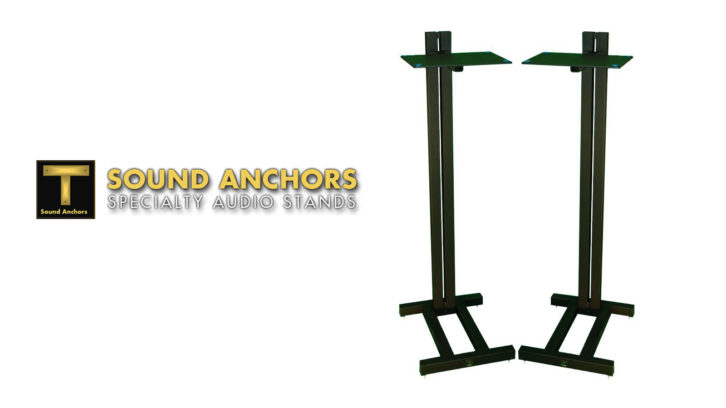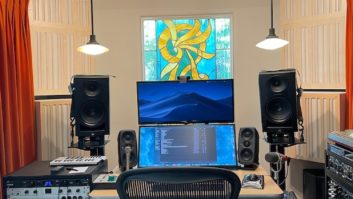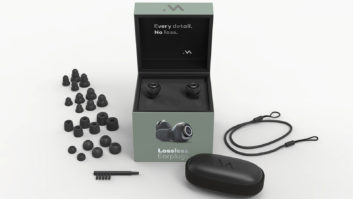
I placed my monitors on the meter bridge area of my studio’s workstation furniture for two decades before moving to a modern ergonomic workstation, necessitating heavy-duty stands to accommodate 80-pound Focal Trio11Be midfields. After a bit of experimentation, I finally settled on the most expensive, heaviest-duty stands I could find anywhere: Sound Anchors ADJ2 stands ($870 a pair, street).
ADJ2s are made entirely of steel, except for the monitor platform shelves, which are 1/4-inch aluminum. A large, squared-up, Pi symbol–shaped base (17 x 23 inches) is made up of 2 x 2-inch square steel tubes, which can rest directly on the floor or be slightly elevated with pointy mounting spikes (which are helpful with precise leveling and to prevent carpet marring), decreasing the energy transfer from vibrating speaker to the floor.
That base houses the vertical “beams” of the stands, which are a pair of equally large square steel tubes and achieve the necessary height (I chose 44-inch maximum height models, but 56-inch-max models are also available). These square steel tubes are filled with sand to decrease resonance and prevent ringing. The monitor platforms (12 x 16 inches) attach directly to these beams with a single large Allen-head bolt, which allows height placement and optional tilt.
Real-World Review: Argosy HaloK Workstation, Rack ’n Roll and Spire 360 Xi Speaker Stands
The entire stand has a flat-black, textured finish but does not have any wire troughs, cable management or cosmetically “stylish” features; these stands “mean business” and are not particularly attractive compared to some of their contemporaries. The ADJ2s can be largely hidden when in use, with positioning possible from behind the monitor, or from the side. I chose side mounting due to placement limitations posed by the large steel legs of the HaloK console workstation.
The two packages were about as heavy as my non-athletic stature could handle, but assembly was possible all by myself, and was actually quick and straight-forward despite the bulk. I brought in an assistant for the installation of my stands, and boy, was I glad I did, as placing and loading the stands properly was a whole different story.
PLACEMENT IS EVERYTHING
I was determined to achieve a 67-inch distance between tweeters, with the tweets right at ear-level and a 30° toe-in for each monitor. Seems easy, right? Wrong! Maybe so with little baby near fields, but not so with big-boy behemoths like Trio11s. First of all, you can’t make any adjustments (height, angle or floor placement) with the monitors in-place; they must be removed from the stands. Secondly, you can’t slide the stands around at all with those pointy spikes digging in (and I’m directly on concrete). Sound Anchors has optional Conecoaster steel pads which can be positioned under each spike to protect floor surfaces.
Hoping to further isolate vibrations from the speaker platforms to the supporting structure, I installed a set of IsoAcoustics Iso-Pucks. These hockey puck–sized “shock absorbers” resist lateral movement and oscillation/vibration, handling 20 pounds each. So I overcompensated with six pucks per monitor—four in the front, where most of the weight lies, and two to the rear.
Frankly, the pucks made the installation more difficult, as they tended to stick to the bottom of the monitors each time we removed them to fine tune the placement of the stands. Effort well spent in my opinion, as very little vibration is felt in the vertical steel beams even when the monitors are pumping out high SPL bass-heavy content. Finally, getting those speaker platforms to either entirely flat, or sightly angled downward, if you’d prefer, is not easy without a level and a helper.
After completing installation, the look is simply perfect, with big monitors perched just above the workstation, neatly paralleling the angles and lines. Strength and sturdiness emanate from the stands, based on the square angles and thick (obviously steel) supports.
THE RESULTING SONICS
The sound showed only a slight improvement as compared to my previous stands. We perceived slightly more neutral bass response and slightly more solid/stable imaging, perhaps a bit more front/back depth to the soundstage, too. Such finite details are hard to confidently confirm with perception (and confirmation) bias(es), but my assistant (who is not at all prone to hyperbole or coercion) noticed the same traits.
All things considered, I’m very happy with the ADJ2s. They hold very large monitors firmly, exhibit no ringing or resonance, and look to be quite the long-term investment. One less variable to think about in my quest for the perfect control room environment.
PRODUCT SUMMARY
Company: Sound Anchors
Product: ADJ2 monitor/speaker stands
Website: https://soundanchors.com
Price: (per pair) 44” $870, 56” $945
Pros: absolute sturdiness, very adjustable, industrial look
Cons: expensive, no cable management, difficult installation







